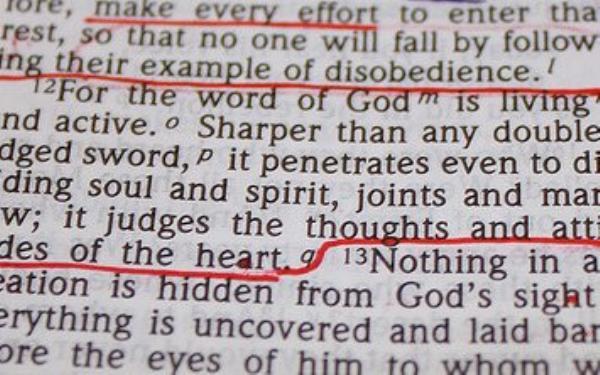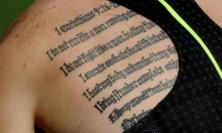When we file out of church at the end of Sunday Mass, we may well remember the topic of the gospel and retain points from the homily preached on it, but what if we were to be asked about the passage read as the Second Reading? Peter Edmonds SJ helps us to make something of the readings from the Letter to the Hebrews that we will hear over the next four weekends.
Long ago, a few decades after the death and resurrection of Jesus Christ, a gifted and learned pastor wrote a fine sermon for his people. It proved so successful that other Christian communities arranged to hear it, and eventually it was included among the twenty-seven books that make up our New Testament. There we find it, sandwiched between the letters attributed to Paul and those attributed to James, Peter and John. If we admit we have never read it for ourselves, nonetheless we can be consoled by the fact that we are not entirely ignorant of it, because if we are Catholics and regular Sunday Mass-goers, we will have heard extracts from it – some would say regrettably short extracts – read out as Second Readings in our liturgies. We know this sermon, with a few verses added at its conclusion to give it the form of a letter (13:22-25), as the Letter to the Hebrews.
We hear these extracts in three blocks over the three-year cycle of the Sunday Lectionary. The first block consists of six passages read out on various special days. The second block consists of a series of seven passages situated at the end of the second year of the Sunday cycle; these introduce us to the particular vision of Christ which this pastor longed for his people to grasp. The third block, a series of four paragraphs proclaimed towards the end of the third year of the Sunday cycle, outlines the sort of life his hearers were to live as followers of Christ in a hostile and alien world.
The First Series: Special Days
On Christmas morning, we hear the solemn opening verses of this sermon (Hebrews 1:1-6). These offer a rich entrance to the whole; they celebrate how in these last days God has spoken to us, no longer through angels or prophets, but through a Son. If at the Christmas Midnight Mass, we saw Jesus as a tiny child in a Bethlehem cave, we now contemplate him as ‘the reflection of God’s glory and the exact imprint of God’s very being’. He now sits at the right hand of the Majesty on high. This picture of the exalted Christ is to dominate all that follows in the rest of the sermon.
We hear this preacher again on the Feast of the Holy Family in Year B. Here he is reflecting on faith. Faith for him means the habit of recognising the activity of God in our own world together with a conviction that the future too is in God’s control. Such a faith marked the lives of the heroes and heroines of Israel’s past. Abraham and Sarah are the persons mentioned today (11:8, 11-12, 17-19). Here is a holy family that lived in the presence of God centuries before the Holy Family of Mary and Joseph, whom we commemorate on this feast of the Christmas season.
We hear our preacher again on the 5th Sunday of Lent during Year B and every year on Good Friday. One passage is heard on both days (5:7-9). Its language puts us in mind of the Gethsemane scene in the gospels (Mark 14:32). It tells in vivid terms how, although he was a Son, Jesus learned obedience through what he suffered. His offering to the Father was one of loud cries and supplications. Such a passage offers us a blunt reminder of the true humanity of Jesus. On Good Friday, we also hear the preceding verses. These console us by describing Jesus as a high priest who has been tested as we are but who is without sin; he is a high priest from whom we can find mercy and grace to help in time of need (4:14-16). On the other readings of this day, we learn from Isaiah how Jesus is servant (Isaiah 52:13-53:12) and from John how he is king (John 18:1-19:42). Hebrews tells us that he is our priest, too.
On Ascension Day in year C, Hebrews provides a supplement to the reading from Acts of the Apostles that is read every year on this day (Acts 1:1-11). There we learn how Jesus departed from this earth for heaven at the end of his earthly life. Hebrews tells us what happened when he arrived in heaven and the consequences for us. He appeared in the presence of God on our behalf (9:24-28). Because of this, we are to hold fast to the confession of our hope without wavering, and we are to encourage one another, because ‘the Day’ is approaching when we will meet the Lord face to face (10:19-23).
A fuller title for the feast of Corpus Christi is ‘The Body and Blood of Christ’. On this feast in year B, we contemplate with the author of Hebrews how Christ, ‘entered once and for all in the Holy Place, not with the blood of goats and calves, but with his own blood, thus obtaining eternal redemption’ (9:11-15). These words of the preacher lead us to a better understanding of the words of Jesus at the Last Supper: ‘this is the blood of the covenant which is poured out for many’ (Matthew 26:28).
The Second Series: a Great High Priest
In contrast to the passages from Hebrews met so far, those which are selected as Second Readings in the final Sundays of Year B (Sundays 27-33) form a series that constitute a sort-of narrative. Our preacher likes to mix doctrine with exhortation and we meet both types of writing on these Sundays.
We begin with doctrine. The opening chapters of the sermon are all about the dignity of the person of Christ. Our short reading on Sunday 27B (Hebrews 2:9-11) provides a summary. Its words remind us of two passages from Paul. In Philippians, he wrote of the humiliation of Christ in his passion and his exaltation through his resurrection (Philippians 2:6-11). In Romans, Paul taught how Christ was the first born of many brethren (Romans 8:29). Here we find these Pauline insights combined. This description of Christ elaborates the portrait offered to us in the prologue to Hebrews which we heard on Christmas Day.
On the next two Sundays, we hear words of exhortation rather than doctrine. In his third chapter the preacher provides a lengthy meditation on Psalm 95, which described how the people of Israel in their desert wanderings failed to enter the rest God was offering them. This warning finds a climax in the reading for Sunday 28B (4:12-13). He describes the Word of God as a two-edged sword, the sort of sword that an executioner would wield to carry out the sentence of the judge who has pronounced a guilty verdict. This is an example of the disturbing and challenging language he sometimes employs because the zeal of some has gone cold (6:6) or because they have become dull of understanding (5:11). But more typical of this author are passages of exhortation which encourage, and typical encouragement follows immediately. Such is the reading for Sunday 29B (4:14-16). It is a passage also used on Good Friday: Jesus is described as a high priest. He has already been described as a high priest who is trustworthy and full of compassion (2:17). We can approach him with boldness. There we will find mercy and he will give us grace which will assist our needs.
On the next four Sundays, the preacher helps us explore further the nature of the high priesthood of Jesus. This is the area in which this sermon is most original, because nowhere else in the New Testament is Jesus called a high priest. Other writings have quoted the first verse of Psalm 110 about Jesus being the Son (Acts 2:34), but only in Hebrews is the verse of the psalm quoted about him being high priest ‘according to the order of Melchizedek’. On Sunday 30B (5:1-6), we learn how Jesus was a priest of a different order from the priests whom we meet elsewhere in Scripture. They belonged to the succession of Aaron, the priest brother of Moses and to the priestly tribe of Levi; Jesus was related to neither of these. His priesthood was that of the mysterious priestly figure called Melchizedek. The preacher would mention later how Abraham met him and gave him tithes, thereby acknowledging his superiority (7:4; Genesis 14:17-20). He has much to tell us about Melchizedek in this same chapter (7:1-17) and we can regret that his report of this meeting is not part of our Sunday liturgy.
Jesus was also a new kind of priest because he has no need of companions in his priesthood and because he lives forever making intercession for us. Death cannot bring his ministry to an end as it did other priests. He continues to be holy, blameless, undefiled and exalted above the heavens. This is the meditation on the priesthood of Christ offered to us on Sunday 31B (7:23-28). On Sunday 32B (9:24-28), our attention is drawn to the place where a priest conducts his ministry. In the book of Exodus, instructions were given on how to construct a tabernacle for priestly ministry (Exodus 26:1-37). King Solomon built a Temple in Jerusalem (1 Kings 6). King Herod had built a replacement (John 2:20). Jesus, as priest, does not need such a man-made sanctuary, because he conducts his ministry in the Holy Place which is heaven and is indestructible.
In the final reading in this series on Sunday 33B, the argument turns to the numerous sacrifices that the priests of old had to offer that could never take away sins. In contrast, the one sacrifice offered by Christ as priest was sufficient to deal with sin, and sanctified all those for whom it was offered. Hence the people of God become a holy priesthood, which is a doctrine stressed both in 1 Peter (2:5) and in Revelation (1:6). Our high priest remains at his seat next to the Father until, in the words of the psalm, ‘his enemies have been made a footstool under his feet’ (Psalm 110:1); or in Pauline terms, until the time, ‘when he hands over the kingdom to God the father’ (1 Corinthians 15:24). With this passage (10:11-14, 18), the second readings for Year B of the Sunday cycle conclude.
The Third Series: The Christian Life
If the readings from Hebrews in year B enriched our understanding of Christ as our priest, the four passages read in the following year C instruct us how to apply the doctrines and exhortations we have heard to our day-to-day lives as Christians.
The passage selected for Sunday 19C(11:1-2, 8-19) is the longest of our readings from Hebrews. We have already met part of it on the feast of the Holy Family. It concerns Abraham and Sarah. They are but two figures out of many who lived lives of faith in the past. They knew that God is active in our lives and that his future plans are worthy of trust. Abraham showed faith when God instructed him to leave his country and his family (Genesis 12:1). He trusted the promise of God that despite his own age and Sarah’s, he would be the father of many nations (Genesis 15:7). He did not hesitate when he was ordered to sacrifice his son Isaac (Genesis 22). Paul too holds Abraham up as a model believer (Romans 4:17; Galatians 3:6). The God of Abraham is a God who has power even to raise the dead (Romans 4:24), and is revered by Jew, Muslim and Christian.
In our second passage, on Sunday 20C (12:1-4), the preacher places us in a stadium. Paul, writing to the Corinthians, had compared the Christian life to a race in the stadium (1 Corinthians 9:25). He knew that he himself had not yet reached the finishing post (Philippians 3:12). In his last hours, he would boast that he had finished the race (2 Timothy 4:7). Hebrews extends this sporting image. We are all competing in the race of faith and a great crowd is watching us from the clouds above, composed of the great figures of salvation history such as Abraham and Moses (Hebrews 11). But there is one who has already run the race of faith and won. This is Jesus and he, too, is watching us. His passion and death were the race he ran. He endured the shame of the cross and the prize he won was a seat at the right hand of God (Ps 110:1; Philippians 2:8-9; Luke 22:69).
The preacher did not pretend that Christian life was easy and on Sunday 21C, we find ourselves to be like children under a demanding teacher or severe parent. The strict father, prepared to discipline his son, was a familiar figure in Jewish ‘wisdom’ tradition (Proverbs 5:12; Sirach 23:2). This figure knew that application and good order were paths that brought about improvement and achievement. The preacher uses this image to comfort his hearers in times of stress and discouragement. He appeals to them to use their bodily facilities to their potential: no more limp hands, trembling knees, injured limbs! Once again he puts before them the picture of ‘Jesus, who leads us in our faith and brings it to perfection’ (12:5-7, 11-13).
The passage selected for our final reading from Hebrews on Sunday 22C (12:18-19, 22-24) introduces us to a final contrast, this time between the old and the new covenant. The old covenant was that of Mount Sinai, marked by darkness and a storm, thunder and a deafening voice. The whole atmosphere caused terror and fear. In contrast, characteristic of the new covenant brought about by Jesus, is the heavenly Jerusalem. Millions of angels enjoy a festival. The saints are there and most importantly Jesus himself, who pleads on our behalf. The blood he shed has brought us purification. The Book of Revelation helps us to appreciate the picture. There, too, we read of the throne room of God where the slaughtered lamb takes his place (Revelation 5:6) and we view the new Jerusalem come down from heaven to earth, where God lives among his people (Revelation 21:2-3).
We appreciate a good sermon. In our Sunday lectionary, we only have the opportunity to enjoy the highlights of the sermon that is the Letter to the Hebrews. One can debate how far the editors have selected the best parts by reading the whole for oneself. Certainly the texts provided can lead to a richer understanding of special days in the Church’s year, of the person of Christ who is ‘the same yesterday and today and forever’ (13:8), and of the way of Christian life, because here, ‘we have no lasting city, but we are looking for the city that is to come’ (13:14). The person who wrote the Letter to the Hebrews remains unknown to us, but he asks for our prayers (13:18) and we in our turn ask for his.
Peter Edmonds SJ is a member of the Jesuit community at Stamford Hill, North London.






